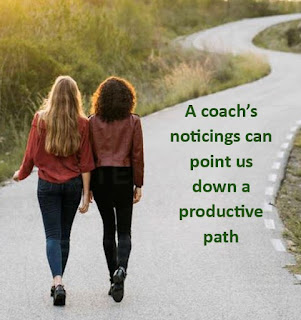Curiosity
and credibility are two valuable coaching ingredients. The trust that is
necessary for coaching includes both relational trust and experiential trust. The
teachers you are working with need to feel seen and
safe in your presence, and they need to feel that you are credible and that you believe they are, too. Credibility comes from knowing that you are drawing from you own experience and from you knowledge in the field. Teachers need to know they can trust any counsel you might provide. So they have to know you know some things. However, your confidence will be best received if it is quiet confidence paired with curiosity.
When
working with teachers, ask questions from a place of authentic wonder. Wonder
with the teacher about why something happened and how it might happen. Ask
questions that demonstrate your curiosity and openness. Asking “Why
do you think…” with curiosity provokes useful analysis. Questions can evoke
teachers’ curiosity, and the best questions are those about which coaches
themselves are authentically curious. When coaches ask with genuine curiosity,
we communicate respect and show faith in the teacher because we demonstrate
that we value what he has to say.
It can sometimes be hard to pull away from
our own knowledge and experience enough to ask an authentic question. We have
to mentally set aside the answer we would give so that we can care more about
the teacher’s response.
When
a teacher says she wants students to be able to show their thinking, we might
authentically ask, “What does that look like to you?” When a teacher says she wants students to
describe their problem-solving process, we might ask, “Can you think of a time
when students really showed their thinking in their work?” When reviewing
student work, we might ask, “What is really important to you in this
assignment?” Authentic questions like these seek the teachers’ perspectives and
insight.
Even
when making a recommendation, you can frame it with wondering, “I wonder
whether this or that might help?” Then ponder
the possibilities together. Here are a few wonderings I’ve had during coaching
conversations:
“I
wonder what differentiation could look like for this assignment.”
”I
wonder if there are a couple of places in this lesson where partner talk would be
helpful.”
“I
wonder if your team might have some ideas about this?”
These wonderings are recommendations with a
soft edge that invite opportunities for discussion. Using the “I wonder”
statement calls the teacher you are working with into inquiry.
Coaching
trust is built but through a steady presence grounded in both experience and
inquiry. When teachers sense that you truly see them, that you honor their
work, and also that you bring hard-earned knowledge to your conversations,
trust grows. It’s not about showcasing expertise; it’s about offering it with curiosity.
Quiet confidence, paired with genuine curiosity, invites collaboration and
deepens the coaching partnership.
This week, you might want to
take a look at:
safe in your presence, and they need to feel that you are credible and that you believe they are, too. Credibility comes from knowing that you are drawing from you own experience and from you knowledge in the field. Teachers need to know they can trust any counsel you might provide. So they have to know you know some things. However, your confidence will be best received if it is quiet confidence paired with curiosity.
Maximizing
coaching in the month of May:
https://dianesweeney.com/maximizing-coaching-month-may/
To wrap up National Poetry Month, consider how poetry supports emotional learning:
https://www.edutopia.org/article/how-poetry-supports-sel-elementary-school/
Is there a writing process?
https://choiceliteracy.com/article/exploring-the-writing-process/
Creating language mindfulness about student equity:
https://www.ascd.org/el/articles/how-our-language-feeds-inequity
Teaching social-emotional skills: Better than a forced, “Sorry!”
https://offspring.lifehacker.com/what-to-say-to-little-kids-instead-of-say-sorry-1819288365
That’s it for this week. Happy Coaching!
Want more coaching tips? Check out my book, Differentiated Mentoring & Coaching in Education: From Preservice Teacher to Expert Practitioner, available from Teachers College Press! I’m so excited to share it with you! You can use the code: FDNS25 for 20% off. Click here and I’ll email you the free Book Group Study Guide that includes questions, prompts, and activities you can use as you share the book with colleagues. I hope you’ll love this book as much as I loved making it for you!
To wrap up National Poetry Month, consider how poetry supports emotional learning:
https://www.edutopia.org/article/how-poetry-supports-sel-elementary-school/
Is there a writing process?
https://choiceliteracy.com/article/exploring-the-writing-process/
Creating language mindfulness about student equity:
https://www.ascd.org/el/articles/how-our-language-feeds-inequity
Teaching social-emotional skills: Better than a forced, “Sorry!”
https://offspring.lifehacker.com/what-to-say-to-little-kids-instead-of-say-sorry-1819288365
That’s it for this week. Happy Coaching!
Want more coaching tips? Check out my book, Differentiated Mentoring & Coaching in Education: From Preservice Teacher to Expert Practitioner, available from Teachers College Press! I’m so excited to share it with you! You can use the code: FDNS25 for 20% off. Click here and I’ll email you the free Book Group Study Guide that includes questions, prompts, and activities you can use as you share the book with colleagues. I hope you’ll love this book as much as I loved making it for you!




